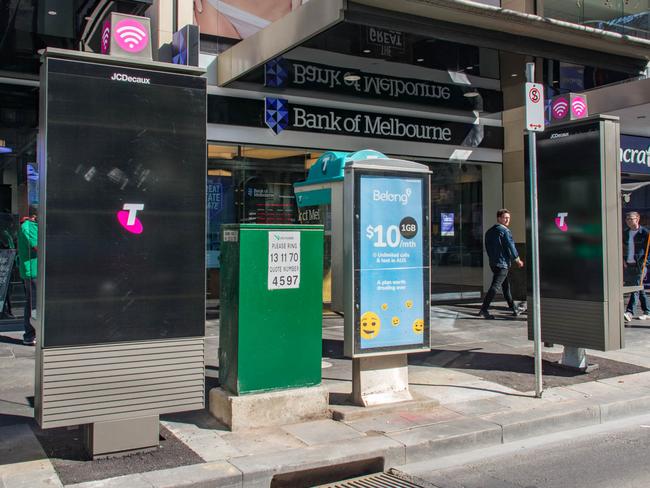Council consider legal action against Telstra for its ‘super-sized’ payphone upgrades
A LEGAL loophole is making one city weave and duck between Telstra’s “super-sized” payphones while the company makes millions.
THANKS to smartphones, public payphones are well on their way to the world’s tech graveyard to live with the likes of CD players and video cassettes.
But not everyone is ready to call time on the streetside boxes, with Telstra recently announcing it plans to upgrade 1800 payphones all around Australia.
The upgraded structures, which measure 2.65m high and 1.09m wide, are nearly 50 per cent larger than the previous installations and come with a digital screen the company rents out to advertisers.
The “super-sized electronic billboards”, as one City of Melbourne councillor calls them, have become a point of contention in the Victorian capital with the local council today confirming it’s considering legal action against the telco in a bid to stop more upgrades.
“These structures are advertising billboards masquerading as payphones. Complaints from the community tell us that they are impeding pedestrians, disrupting footpath traffic flow and negatively impacting a number of local retailers and businesses,” City of Melbourne’s planning portfolio chair Councillor Nicholas Reece said.
Each CBD billboard, which flash through three to four advertisements a minute, can earn Telstra up to $8000 a week in revenue.
“For 120 in prime locations throughout the city centre, that’s millions of dollars per year going to Telstra with no rental costs or compensation for the imposition on our public spaces,” Mr Reece said.
Telstra has already upgraded 17 of its 120 payphones throughout Melbourne after the city council approved the digital revamp on 40 sites back in 2016.

The company is hoping to upgrade the remaining 80 scattered throughout the capital and labelled the council’s legal action comment “disappointing”.
“We have been liaising with the City of Melbourne over a number of years, including as recently as last month, on this issue,” a Telstra spokeswoman said.
A legal loophole means the company is able to keep the payphones on the street without paying any rent for the space while it’s also able to pocket the ad revenue.
Under the Federal Telecommunications Act of 1997, companies do not have to seek planning approval when installing telecommunications infrastructure, as long as it’s regarded as “low-impact facility”.
Mr Reece said Telstra was using the 1997 Act to avoid consulting with the local council.
“Legal action is a last resort but we must protect our valuable and scarce public space from being co-opted for profit without proper consideration of the community impact,” he said.
“Currently, it appears as though Telstra is utilising federal legislation to effectively sidestep any genuine consultation process.”
If each of the city’s payphones can net Telstra $8000 a week, the company stands to make close to $50 million from the billboards.
Melbourne has long been Australia’s most walkable city but Mr Reece said Telstra’s new payphones were becoming annoying for city dwellers.
“We are not going to sit idly by and allow the plundering of the public realm for private profit,” the councillor said.
Telstra said it had been respectful of the planning process and the payphones in the City of Melbourne were being installed in accordance with relevant legislation.
“Planning approval for the advertising component of the upgraded payphones was given by City of Melbourne Council in 2016,” a spokeswoman said.
In a statement, City of Melbourne said it had been contacted by other local councils in Victoria that were also concerned about the billboards.
“The Cities of Port Phillip, Maribyrnong, Stonnington and Yarra have advised they are equally concerned that the new Telstra structures are significantly disrupting footpath traffic and negatively impacting the public realm,” a spokesperson said.
The City of Melbourne has invited the public to have their say about the billboards and to help the council “understand how the new Telstra digital advertising payphones” will impact them.
A Telstra spokeswoman said the company planned to meet with the council “to continue discussing their concerns”.



